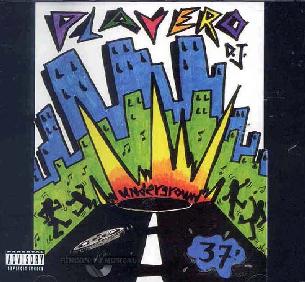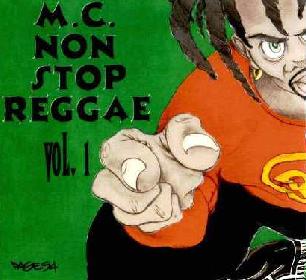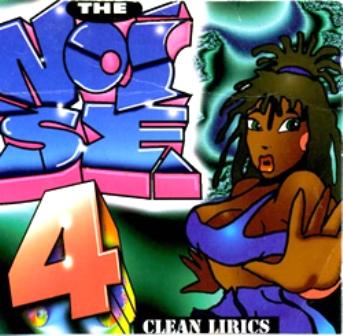!cabron! que reggaeton !
 remember that observation i made last summer with regard to the snares in reggaeton?
remember that observation i made last summer with regard to the snares in reggaeton?well, i've put together a thing or two since then that help explain where this remarkable, distinctive practice of switching snares every several measures or so has its beginnings: puerto rico in the early 90s, of course, i.e., during the dembow era, when underground referred to raggamuffin flows over sample-based beats, and when top DJs/producers, such as playero, and night clubs / mixtape series, such as the noise, were synonymous with a genre that wasn't so much unnamed as overnamed, bursting with significance and signification, and perhaps not so much "underground" as it was "undergrown" (as i once misread the cover as saying).
it was no doubt growing assiduously, though, and the music and scene have undergone a great deal of growth and change since those early days. even so, the latest reggaeton productions continue to embody this early history - significantly submerged as it may be - in their very sonic structure. mainly, the snares. you see, back in the days of what dj/rupture calls "proto-reggaeton," when the spanish-language reggae/rap made in san juan was called any number of things (including some nasty epithets), you could hear the snares switch just as regularly as you do now. you might not notice though, since everything else would change too.

if you listen to puerto rico's underground music of the 1990s you hear - by and large - a series of flip-tongue, sing-song vocalists rocking risque over homemade versions of recent reggae riddims and hip-hop beats. the favorites are ubiquitous - dem bow, bam bam, drum song - and they cycle in and out of the half-hour to hour mixes that constituted the genre's main medium throughout the decade. not on a song to song basis, mind you, but on a section to section basis, so that a four-bar chop'n'stab loop of the dem bow would be followed by a similar version of a version of the bam bam, then something of the drum song, and so on.
frequently, not only are these loops reassembled - sample-based hip-hop stylee - from well-worn reggae riddims, they're composites of several of them. thus, at times, the dem bow drums might roll along with the bam bam guitar and/or the drum song bass - not to mention the syncopated snare and heavy hi-hat from slick rick's "mona lisa," the sax riff from the 45 king's irrepressible, irresistable "900 number" loop, the bassline from special ed's "i got it made," marley marl's immortal "symphony"-flip of otis redding's piano intro, and various other old school and contemporary hip-hop references. these chopped-and-rearragned loops of recognizable fragments make for a rather resonant mix, and over such steadily shifting accompaniment spanish-slanging MCs with dancehall-derived flows skip triple-time over the beats, often while intoning one of those two-or-three-note dancehall melodies that jamaican DJs have endlessly reworked since the early-mid 80s and which are especially characteristic of early 90s dancehall (a/k/a, ragga).

so those famous shifting snares in all the newest nuendo-nicked pistas played and programmed by luny tunes, et al., are quite closely connected to this foundational practice of versioning the versions, of taking a hip-hop hatchet to reggae's pop-will-eat-itself aesthetics, creating dense, sample-based collages that engage and embody, as they directly index, the popular and no doubt political (for san juan youth) "musica negra," as they used to sing on mixtapes before the tagline became "reggaeton latino" - the "black music" that resounded across the soundscapes of san juan and new york, home and home-away-from-home, and animated a specific sort of youth- and class-based cultural politics in the late 80s and throughout the 90s.
in some ways, the practice is rather consistent with dancehall reggae's own approach to riddim production in the early 90s. think of cutty ranks's "a who seh me done (wake the man)," which shuffles between the familiar strains of the bam bam and a downbeat-centric, hip-hop-inflected beat, or dave kelly's action riddim - another favorite source for underground pistas (via that inescapable terror fabulous and nadine sutherland joint) - a track which juxtaposes starkly contrasting calls and responses to create an effective, affective form. (really, who can resist when the riddim's propulsive percussion yields to - or breaks before - that gloriously naked, bubbling bassline?) the approach also presents a striking parallel to brazilian funk's deployment of a small set of core (electro/bass-derived) rhythm tracks against a panoply of pop culture references - as sampled, as shouted, as captured in a ringtone.

hearing so many snares with new significance, i wonder whether the change in sound mirrors or informs an attendant shift in cultural politics? does this receding presence of hip-hop and reggae, this disappearing sonic blackness, overlay with a broader drift from class-bred commitments to racial and social justice? as samples of jamaican and african-american music yield to synth melodies inspired by merengue, bachata, salsa, freestyle, club/house, and even "tecno" (que chipmunk hoovers!), how do these figures inform the lines of community we draw in our imaginations and interactions? what might the ghostly connections between today's slick, synthetic anthems and the rough-and-rugged, cut'n'paste pistas of the 90s say about race and nation then and now?
.. boom ..
i don't know how long it will be up, but for those of you looking to follow this thread yourselves, there is no better resource than lobo lansky's: an utterly amazing and comprehensive archive of reggaeton albums and mixtapes from the seminal playero 37 to don omar's new highest-charting reggaeton debut. dude's got links to videos, too. not all of the albums are uploaded yet, but lansky intends to have it finished and fleshed out to eight pages (!) by july. since he's only streaming, he may be able to keep it up for a while, but i recommend checking it out while it's still right there in all its digitized splendor.

i highly recommend it, actually. i gotta say, i really enjoy this music. not only is it full of resonant references to a lot of my favorite tunes, it's bursting with energy and creativity (despite being so deeply "derivative"). it's fun, funny, and occasionally poignant. it's unhinged and uninhibited. it's critical as it's conservative. it's vanguard and rearguard at once.
it's all mixed up and not afraid to show its seams.
.. cha-boom chick ..
happy listening over at lansky's - keep yer ears on the snears !!
and your eyes, well, here's something for them (from playero 40):



7 Comments:
que fuerte... otra vez, me dejas viendo la música con ojos nuevos. lo de lanksy es un tesoro de verdad (big up playero!). j
tuning into cuban radio - not to mention catching signals from as far north as miami, memphis, and even cincinatti - seems to be a common part of jamaican musical lore. who knows, drew, you may have caught a puerto rican broadcast, too. reggaeton's been popular in cuba for a while now, though, so it's quite likely that's what you were hearing.
and thanks to you and jace for the kind words. just trying to put some things together here..
Im a Dj/Producer in the US (Cleveland, Ohio) and im trying 2 come up so if you need a beat let me know, im known 4 my style that i have in HARD CORE Reggaeton, i use FL Studios with every Libray and Every Plug in i have ever seen, DjKennyKiloz@Aol.com and let me know whats gudd, This is the Year 4 Reggaeton so DJ Kenny Kiloz is doing it!!!!!!!!!!!!!!!!!!!!!!!
Thank you for these insightful posts on reggaeton (and everything else). I'm going to make them required reading for my students as an example of quality info on the internet ('cause frankly, with all the stuff posted about reggaeton on the internet, you would think the dialogue would be richer).
I like all the articles you have written so far, concerning reggaeton. You mentioned something that I have seen lately on all reggaeton tracks, they all have a lot of creativity. I mean real crazy creativity. Like for example wisin y yandel newest song where wisin screams with the synth in the baclground. I mean are this people geniuses, you just have to go beyond the lyrics, and appreatiate the music. Don't mention the melodies, and the Tiny Tunes who is the best producer right now is only 16 or 17, everything he makes is hot. Plus the flow flow flow, thats why their first albulm is called "Mas Flow". lol If you listen to any hot song you notice the extreme flow it has. Just hear how the dembow flows with the melody and how the cortes transition smoothly through the song. Everything is computer programed so is amazing for me. If you listen to Dale don Dale, and you hear a "Top of The Line" or better yet "los Benjamins" you'll notice the evolution of reggaeton.
myspace.com/ezekielz2 check out my music
Listen to Dembow dominicano
thanks for the tip! i'm a big fan of dembow dominicano, which, as you suggest, returns to the playero aesthetic that i clearly love so much. see, e.g., this recent post at my blog's re-located home:
http://wayneandwax.com/?p=2759
Post a Comment
<< Home